
A hedgehog is a spiny mammal of the subfamily Erinaceinae, in the eulipotyphlan family Erinaceidae. There are seventeen species of hedgehog in five genera found throughout parts of Europe, Asia, and Africa, and in New Zealand by introduction. There are no hedgehogs native to Australia and no living species native to the Americas. However, the extinct genus Amphechinus was once present in North America.
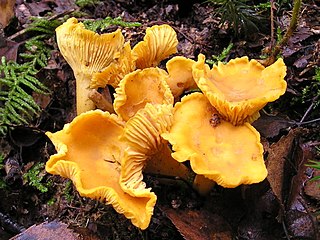
The Cantharellales are an order of fungi in the class Agaricomycetes. The order includes not only the chanterelles (Cantharellaceae), but also some of the tooth fungi (Hydnaceae), clavarioid fungi, and corticioid fungi (Botryobasidiaceae). Species within the order are variously ectomycorrhizal, saprotrophic, associated with orchids, or facultative plant pathogens. Those of economic importance include edible and commercially collected Cantharellus, Craterellus, and Hydnum species as well as crop pathogens in the genera Ceratobasidium and Thanatephorus/Rhizoctonia.

Hydnum repandum, commonly known as the sweet tooth, wood hedgehog or hedgehog mushroom, is a basidiomycete fungus of the family Hydnaceae. First described by Carl Linnaeus in 1753, it is the type species of the genus Hydnum. The fungus produces fruit bodies (mushrooms) that are characterized by their spore-bearing structures—in the form of spines rather than gills—which hang down from the underside of the cap. The cap is dry, colored yellow to light orange to brown, and often develops an irregular shape, especially when it has grown closely crowded with adjacent fruit bodies. The mushroom tissue is white with a pleasant odor and a spicy or bitter taste. All parts of the mushroom stain orange with age or when bruised.
Hedgehog mushroom is a common name of several fungi species and may refer to:
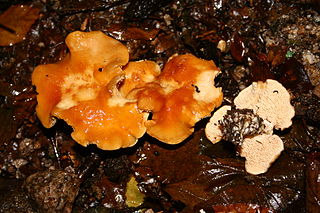
Hydnum rufescens, commonly known as the terracotta hedgehog, is an edible basidiomycete of the family Hydnaceae. It belongs to the small group of mushrooms often referred to as the tooth fungi, which produce fruit bodies whose cap undersurfaces are covered by hymenophores resembling spines or teeth, and not pores or gills.

Hydnum is a genus of fungi in the family Hydnaceae. They are notable for their unusual spore-bearing structures of teeth rather than gills. The best known are the edible species Hydnum repandum and H. rufescens. There are no known toxic varieties of Hydnum. Widely regarded as important maintainers of forest ecosystems, the Hydnum genus is known to have ectomycorrhizal relationships with multiple plant families. Hydnum has many brittle, white teeth from which the spores drop. Some species have teeth which hang from ascending branches, while other species have teeth which project downwards from the undersurfaces of dead wood. Most Hydnum species are safe to eat, and contain many fatty acids and antioxidants.

The Hydnaceae are a family of fungi in the order Cantharellales. Originally the family encompassed all species of fungi that produced basidiocarps having a hymenium consisting of slender, downward-hanging tapering extensions referred to as "spines" or "teeth", whether they were related or not. This artificial but often useful grouping is now more generally called the hydnoid or tooth fungi. In the strict, modern sense, the Hydnaceae are limited to the genus Hydnum and related genera, with basidiocarps having a toothed or poroid hymenium. Species in the family are ectomycorrhizal, forming a mutually beneficial relationship with the roots of trees and other plants. Hydnum repandum is an edible species, commercially collected in some countries and often marketed under the French name pied de mouton.

The hydnoid fungi are a group of fungi in the Basidiomycota with basidiocarps producing spores on pendant, tooth-like or spine-like projections. They are colloquially called tooth fungi. Originally such fungi were referred to the genus Hydnum, but it is now known that not all hydnoid species are closely related.
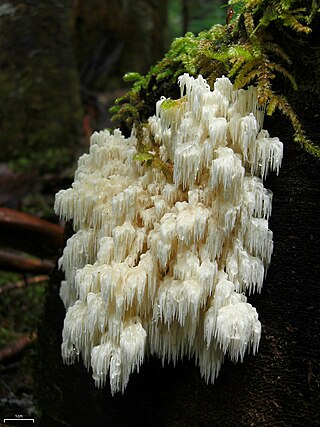
Hericium abietis, commonly known as the bear's head or the western coral hedgehog, is an edible mushroom in the tooth fungus group. It grows on conifer stumps or logs in North America, producing a cream white fruit body up to 10–75 cm (4–30 in) tall and wide. It fruits from after the start of the fall rains to mid-season.

Beenakia dacostae is commonly found growing around parts of Victoria and Tasmania, Australia. Found in the family Clavariadelphaceae this small, stalked fungus has a very smooth, white, wavy cap. Pale olive-brown teeth underneath the cap are long, pointed and extend part way down the stem.

Hydnum umbilicatum, commonly known as the depressed hedgehog, is a species of tooth fungus in the family Hydnaceae. It was scientifically described in 1902 by American mycologist Charles Horton Peck. It is found in North America and in Europe. It is edible and good.

Hydnum ellipsosporum is a species of fungus in the family Hydnaceae that was described from Germany in 2004. It differs from H. repandum by the shape and length of its spores, which are ellipsoid and measure 9–11 by 6–7.5 µm. Compared to H. repandum, it has smaller fruit bodies, with cap diameters ranging from 3 to 5 cm wide.
Hydnum magnorufescens is a species of fungus in the family Hydnaceae native to the southern Europe, Sichuan Province in China and Russia.
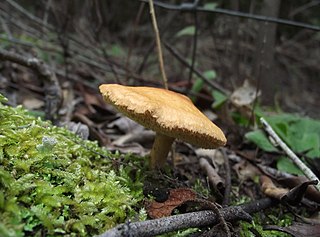
Hydnum ovoideisporum is a species of fungus in the family Hydnaceae native to the southern Europe.
Hydnum vesterholtii is a species of fungus in the family Hydnaceae native to the southern and Central Europe and southwestern China.
Hydnum crocidens is a species of fungus in the family Hydnaceae native to Australia. It was described in 1890 by Mordecai Cubitt Cooke from material collected around Port Phillip Bay. Genetic analysis shows it to be closely related to a lineage containing H. rufescens and its close relatives.
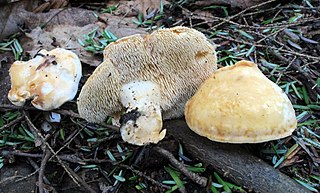
Hydnum albidum, commonly known as the white hedgehog, is an edible species of fungus in the family Hydnaceae native to North America.
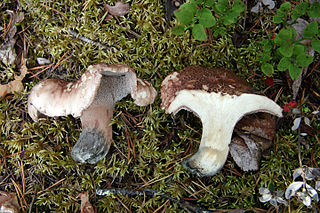
Hydnellum scabrosum, also called bitter tooth or bitter hedgehog, is a species of tooth fungus in the family Bankeraceae.

Hericium cirrhatum is a saprotrophic fungus, commonly known as the tiered tooth fungus or spine face. The species is edible and good eating when young. It has a texture not unlike tender meat or fish. The flesh is cream in colour with an attractive smell when young, but it develops a very unpleasant odour in older specimens.














